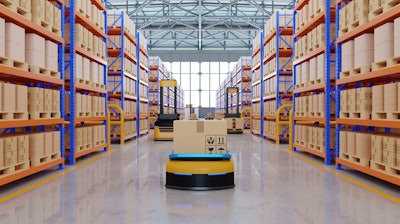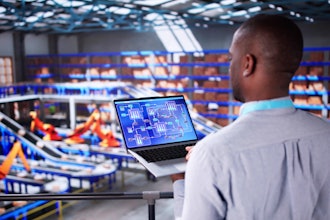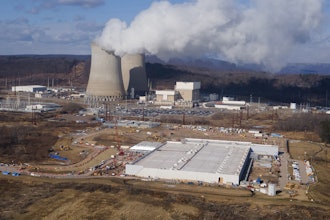
Supply chains, logistics and distribution have all changed tremendously over the past five years.
Competition between manufacturers, distributors and e-commerce-based companies has grown fierce. Growing demand for more efficient distribution centers to serve the e-commerce explosion has prompted prominent corporations to supply automated material handling systems for logistics solutions businesses.
Automation, combined with a solid warehouse management system (WMS), is a sensible way to improve any warehouse operation. Here are five compelling reasons why adding automation to your distribution warehouse operation will make it more efficient and provide a better customer experience.
Labor challenges
Labor challenges continue across the board in distribution. The pandemic-driven e-commerce explosion has exacerbated the scarcity of workers. Shortages are not only limited to front-line positions like pickers, packers, forklift operators and maintenance techs; capable frontline supervisors also are difficult to find and, more importantly, to retain once you have trained them. These labor issues are projected to remain for the foreseeable future.
Automation can help solve several challenges and costs associated with labor shortages. Whether you have little to no automation in your warehouse or have previously started your digital transformation, newly developed and properly deployed automation helps your people and your operation in several ways.
First, automation can perform the mundane tasks your people would prefer not to do. The latest generation of warehouse robotics is designed to work collaboratively with people to make operations safer and more efficient. Reductions in movement and touches reduce injuries to your workforce and the risk of damage to products. Other areas, such as customer service, billing and routine rules-based tasks, can also be improved using structured data through robotic process automation (RPA). RPA mimics human keystrokes on a computer to perform these everyday tasks more efficiently with far fewer errors.
Second, automation reduces the need for additional labor you are already struggling to recruit, hire, train and retain to continue to scale and grow your business. Giving your people the tools to operate more safely and efficiently saves on the total cost of operation. Employees performing more meaningful work are more likely to stay.
Space constraints
There are many ways to save space in your operation by introducing automation and technology. To better utilize space in pallet storage, simply introduce wired guided forklifts and turret/swing reach trucks. Narrow aisles increase storage density while increasing productivity through faster travel speeds.
Automation tools can reduce the overall footprint in your facilities. Goods-to-person storage systems use your facility's available and unused vertical space. This additional space utilization allows you to store more inventory in less space while making your workforce more productive. Automated storage and retrieval systems (AS/RS) allow for automatic storage of pallets providing many benefits, including: better use of floor space by claiming unused vertical space, better product security for high-pilfered inventory, and increased throughput without sacrificing picking accuracy.
Productivity
Workers spend about 70% of their time traveling in a manual warehouse. That leaves only 30% for value-added activities such as picking. Automation makes any operation more productive by reducing the time your workers spend traveling. Robots can perform consistently over a more extended period of time. They do not take breaks or lunches, nor do they call in sick. Robots can perform repetitive tasks consistently, increasing productivity and accuracy.
Automation coupled with the proper software increases productivity. An example of a benefit provided by a WMS solution is directed put-away. In a manual warehouse, the put-away forklift driver must drive around to find a proper bin location to store the pallet. As the warehouse gets fuller, this becomes increasingly difficult and less efficient. Directed put-away uses the system to pick an empty bin location in the storage type for that item, saving time and frustration.
Safety
Repetitive tasks over time can lead to tendinitis and bursitis and injuries to tendons for your workers. Automation of repetitive tasks in warehouses and offices reduces worker fatigue and the risk of accidents and injuries. Replacing forklift drivers with autonomous vehicles reduces congestion and creates a safer warehouse.
Customer service
Customers are demanding better service now more than ever before. Customers want to order what they want, when they want, from whatever device they want, and they want it fast! Adding automation to your distribution operation will help optimize it to provide your customers with faster and more economical products and services. Automation helps drive consistency by reducing errors, increasing customer satisfaction, reducing returns, and correcting shipments.
Warehouse automation came up during a recent conversation with Brendan Breen, president of the Industrial Supply Association. I asked him if he thought distributors could benefit from adding automation to their warehouses and distribution centers? He replied, “Distributor warehouses are fertile ground for automation. The combination of a challenging labor market, highly structured repetitive tasks, and increased margin pressure make this an excellent option for companies looking to gain an edge. And with the rapid advancement of technology, increased access, and lower entry barriers, automation has become an easy choice.”
Warehouse automation will fundamentally change how we staff warehouses and distribution centers. Robots will perform many forklift operator tasks, allowing your people to focus on innovation and better ways to serve your customers. Inventory cycle counting tasks will be replaced by advanced radio frequency identification (RFID), allowing an entire distribution center to have constant real-time bin level accuracy.
Automation helps at every level of your operation. It is the future. Companies that hesitate risk being left behind.
Will Quinn is the director of industry solution and strategy at Infor.






















